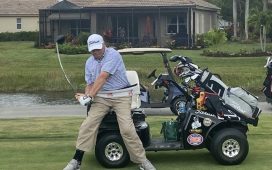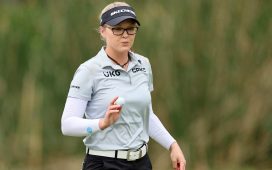Kendall Dye says that in her decade-long professional career, she has seen fingers flashed at players, caddies and media thousands of times. The assertion, made on Twitter, was meant to help explain why she flashed three fingers (signaling an 8-iron) at another player’s caddie during the sixth round of LPGA Q-Series. The gesture was deemed a violation of Rule 10-2, asking for advice, and both Dye and the caddie’s boss, Dewi Weber, were assessed two-stroke penalties.
There’s no question that Dye breached the rule. But is she correct in saying that it’s a common occurrence in professional golf, particularly on par 3s?
Not surprisingly, the answer is complicated.
None of the players or caddies – on both the PGA Tour and LPGA – interviewed by Golfweek for this story can recall having seen a player flash fingers or verbally ask for club information.
In that instance, Dye is an exception.
And it’s perfectly legal for media to obtain club information. Caddies flash fingers to on-course reporters in every marquee group.
But that doesn’t mean the advice rule isn’t broken in other ways throughout professional golf on a regular basis.
“Caddies flash numbers to players and caddies,” said one veteran LPGA player. Because rules violations are a sensitive topic, Golfweek spoke to caddies and players about the issue on the condition of anonymity. “That’s really not uncommon. I bet it happens in every group at least once during the round in every tournament.”
Learning the rule
Five-time PGA Tour winner Mark Wilson is as familiar with the advice rule as anybody. For starters, Wilson can remember reading an article in a golf publication while in high school in the early ’90s that highlighted caddies flashing fingers. (Wilson said there were pictures.)
“It was one of those things where I was awestruck by that,” said Wilson. “It’s a rule. Why are they doing that?”
Little did Wilson know that he’d one day call that penalty on himself. At the 2007 Honda Classic while standing next to his caddie on a par-3 tee box directly in front of Camilo Villegas and his caddie, Wilson overheard a conversation about what kind of hybrid he’d hit.
Wilson’s caddie, Chris Jones, turned around and told them it was an 18-degree.
Villegas and his caddie looked at him quizzically, Wilson said, but didn’t respond.
Wilson immediately called over a rules official and was docked two strokes. Remarkably, the unusual incident propelled him to his first PGA Tour victory.
Hand signals on the PGA Tour, Wilson said, mostly happen between caddies. Wilson has told caddies that he hires ahead of time that they won’t be flashing any fingers. They will, however, keep the bag open for anyone to peek inside (perfectly legal).
Wilson doesn’t believe that the caddies who flash fingers – mostly out of convenience to save someone the trouble of walking over to look in the bag – are trying to cheat. He believes they’re simply trying to help.
But it’s still breaking a rule, and he’d like to see that rule changed. Wilson said he regrets not going to the USGA about it in recent years.
“It would be a little scary,” said Wilson of the ramifications of such a change, “but it would be nice to go down that road and investigate where it might lead.”
A ‘nitpicky’ rule
Two of the LPGA’s most thoughtful players, both veterans, echoed Wilson’s belief that it should change, calling the rule “nitpicky” and “stupid.” Because a player can easily look into a bag to see what club is missing, they say, what’s the harm in a caddie making it a little easier by holding up a couple of fingers?
Several PGA Tour caddies Golfweek spoke to confirmed that fingers are flashed between caddies during most rounds. What’s being done as a matter of convenience is really a violation of Rule 10-2 as a caddie is an extension of the player.
If a player were to walk toward another player’s bag with the intent of looking inside and as she approached, a caddie held up two fingers, the caddie’s boss would incur a two-stroke penalty.
Players have the option of covering up their bag to keep other players from knowing their club selection.
“We laugh at that,” said one LPGA player. “That’s a joke.”
While players might talk a little louder about what club they’re hitting on a Thursday, on Sunday they might drag the head of the club along the ground back to the bag or hand it to the caddie grip first with their hand over the number.
All agree that simply knowing what club a player hit offers no guarantees. They could’ve hit a muscled-up 8-iron or a soft 7. Some players are more concerned with the flight of the ball rather than the distance. Some have zero interest in what their opponents are hitting, believing there are too many variables to consider it an advantage.
One player remembers coming out on the LPGA as a 21-year-old rookie and learning how hand signals work on tour. She never thought much about it until Dye got docked two strokes.
While some believe it’s a “victimless crime,” something that’s not even worth discussing, one player called it a wake-up call.
“This maybe is a culture that needs to stop,” said one longtime LPGA player. “It’s like suddenly everyone thinks they’ve never done it, or their caddies have never done it. All of a sudden everyone thinks their hands are clean.”








